A toy cart of mass kg is pulled by a force of 20N at an angle of with the frictionless horizontal surface on which the cart is placed. The cart shall move on the surface with an acceleration .
The correct Answer is:3
To solve the problem, we need to find the acceleration of a toy cart of mass √3 kg that is being pulled by a force of 20 N at an angle of 30∘ on a frictionless horizontal surface.
1. Identify the Forces:
The force applied to the cart is F=20N at an angle of 30∘ to the horizontal. We can resolve this force into its horizontal and vertical components.
2. Resolve the Force:
- The horizontal component of the force (Fx) can be calculated using:
Fx=F⋅cos(θ)=20⋅cos(30∘)
- The vertical component of the force (Fy) can be calculated using:
Fy=F⋅sin(θ)=20⋅sin(30∘)
3. Calculate the Components:
- Using the values of cos(30∘)=√32 and sin(30∘)=12:
Fx=20⋅√32=10√3N
Fy=20⋅12=10N
4. Apply Newton's Second Law:
Since the surface is frictionless, we only need to consider the horizontal component of the force to find the acceleration. According to Newton's second law:
Fx=m⋅a
where m=√3kg and a is the acceleration we want to find.
5. Substitute and Solve for Acceleration:
10√3=√3⋅a
To isolate a, divide both sides by √3:
a=10√3√3=10m/s2
Final Answer:
The acceleration of the cart is 10m/s2.
---
The force applied to the cart is F=20N at an angle of 30∘ to the horizontal. We can resolve this force into its horizontal and vertical components.
- The horizontal component of the force (Fx) can be calculated using:
Fx=F⋅cos(θ)=20⋅cos(30∘)
- The vertical component of the force (Fy) can be calculated using:
Fy=F⋅sin(θ)=20⋅sin(30∘)
- Using the values of cos(30∘)=√32 and sin(30∘)=12:
Fx=20⋅√32=10√3N
Fy=20⋅12=10N
Since the surface is frictionless, we only need to consider the horizontal component of the force to find the acceleration. According to Newton's second law:
Fx=m⋅a
where m=√3kg and a is the acceleration we want to find.
10√3=√3⋅a
To isolate a, divide both sides by √3:
a=10√3√3=10m/s2
The acceleration of the cart is 10m/s2.
Topper's Solved these Questions
- LAWS OF MOTION BOOK - VMC MODULES ENGLISHCHAPTER - LAWS OF MOTION EXERCISE - ENABLE
50 Videos
- LAWS OF MOTION BOOK - VMC MODULES ENGLISHCHAPTER - LAWS OF MOTION EXERCISE - EFFICIENT
50 Videos
- KINEMATICS OF A PARTICLE BOOK - VMC MODULES ENGLISHCHAPTER - KINEMATICS OF A PARTICLE EXERCISE - JEE Advanced (archive)
14 Videos
- LIQUIDSBOOK - VMC MODULES ENGLISHCHAPTER - LIQUIDSEXERCISE - JEE ADVANCED (LEVEL -2)
55 Videos
Similar Questions
A block of mass m = 10 kg is pulled by a force F = 100 N at an angle θ=30∘ with the horizontal along a smooth horizontal surface. What is the acceleration of the block? (g=10m/s2)
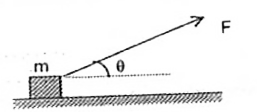
View SolutionA block of mass 20 kg is set into motion on a frictionless horizontal surface with the help of massless smooth pulley and rope as shown in the figure. Find the acceleration of the pulley
_PHY_E05_192_Q05.png)
View SolutionTo keep a particle moving with constant velocity on a frictionless horizontal surface an external force
View SolutionA wooden block of mass M resting on a rough horizontal surface is pulled with a force T at an angle q to the horizontal. If m is coefficient of kinetic friction between the block and the surface, the acceleration of the block is
View SolutionA block of mass of 20kg is set into motion on a frictionless horizontal surface with the help of massless smooth pulley and rope as shown in figure.Find the acceleration of the pulley
_PHY_E05_034_Q01.png) .jpg
.jpg
View SolutionA block B of mass M is suspended from a cord of length l attached to a cart A of mass M as shown in the figure. The horizontal surface on which the cart moves is smooth. Initially both the cart and the block are at rest in the position shown. Now B is released. Take M=m=2kg,θ=45∘andg=10m/s2.
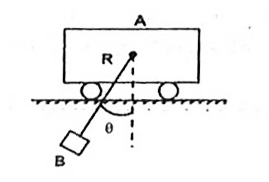
The magnitude of acceleration of B (with respect to cart) immediately after the system is released from rest is
View SolutionA block B of mass M is suspended from a cord of length l attached to a cart A of mass M as shown in the figure. The horizontal surface on which the cart moves is smooth. Initially both the cart and the block are at rest in the position shown. Now B is released. Take M=m=2kg,θ=45∘andg=10m/s2.
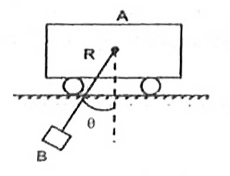
The acceleration of the cart immediately after the system is released from rest is
View SolutionA block B of mass M is suspended from a cord of length l attached to a cart A of mass M as shown in the figure. The horizontal surface on which the cart moves is smooth. Initially both the cart and the block are at rest in the position shown. Now B is released. Take M=m=2kg,θ=45∘andg=10m/s2.
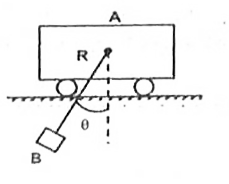
The tension in the cord immediately after the system is released from rest is
View SolutionFig. shows a system of three masses being pulled with a force F. the masses are connected to each other by strings. The horizontal surface is frictionless . The tension T1 in the first string is 16 N. The acceleration of the system is :

View Solution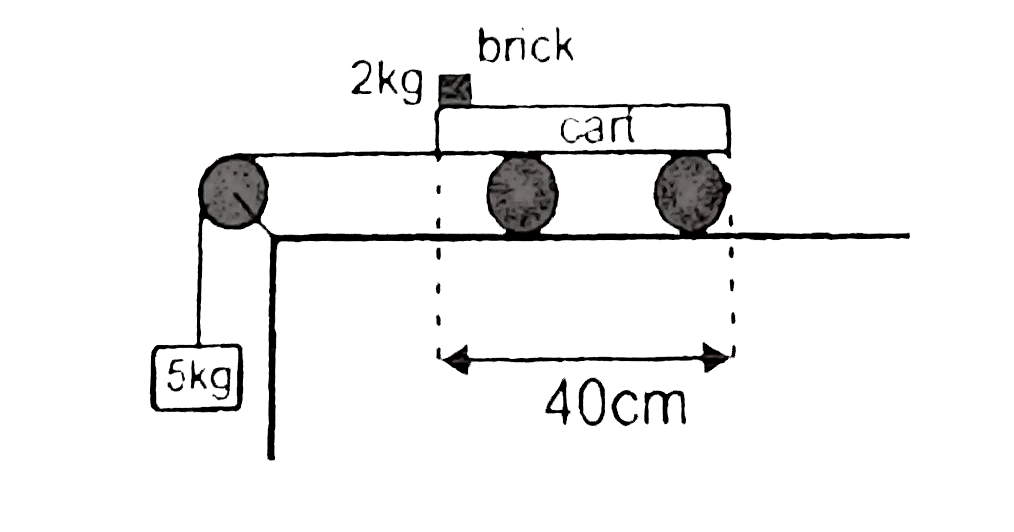
A cart of mass 3 kg is pulled by a 5 kg object as shown in figure. Length of cart is 40 cm moves on frictionless table. There is a small brick of mass 2 kg on the cart which falls at 0.8 sec. after the start of motion. if the coefficient of friction between cart and brick is x10. then value of x is :(g=10m/s2)
View Solution
